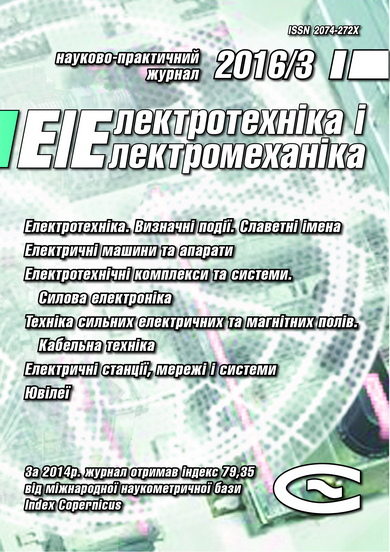MATHEMATICAL MODEL OF ELECTROMAGNETIC PROCESSES IN LEHERA LINE AT OPEN-CIRCUIT OPERATION
DOI:
https://doi.org/10.20998/2074-272X.2016.3.05Keywords:
mathematical modeling, Hamilton-Ostrogradskiy principle, Euler-Lag¬range equation, electric power system, power line with distributed parametersAbstract
Purpose. The work proposed for the modeling of transients in Lehera line uses a modified Hamilton-Ostrogradskiy principle. The above approach makes it possible to avoid the decomposition of a single dynamic system that allows you to take into account some subtle hidden movements. This is true for systems with distributed parameters, which in the current work we are considering. Methodology. Based on our developed new interdisciplinary method of mathematical modeling of dynamic systems, based on the principle of modified Hamilton-Ostrogradskiy and expansion of the latter on the non-conservative dissipative systems, build mathematical model Lehera line. The model allows to analyze transient electromagnetic processes in power lines. Results. In this work the model used for the study of transients in the non-working condition Lehera line. Analyzing the results shows that our proposed approach and developed based on a mathematical model is appropriate, certifying physical principles regarding electrodynamics of wave processes in long power lines. Presented in 3D format, time-space distribution function of current and voltage that gives the most information about wave processes in Lehera line at non-working condition go. Originality. The originality of the paper is that the method of finding the boundary conditions of the third kind (Poincare conditions) taking into account all differential equations of electric power system, i.e. to find the boundary conditions at the end of the line involves all object equation. This approach enables the analysis of any electric systems. Practical value. Practical application is that the wave processes in lines affect the various kinds of electrical devices, proper investigation of wave processes is the theme of the present work.References
1. Shimoni K. Teoreticheskaya elektrotekhnika [Theoretical Electrical Engineering]. Moscow, Mir Publ., 1956. 773 p. (Rus).
2. Available at: https://www.energetika.in.ua (Accessed 25 July 2014).
3. Nayir A. Simulation of transient processes on overvoltage in electric transmission lines using ATP-EMTP. Turkish Journal of Electrical Engineering & Computer Sciences, 2013, no.21, pp. 1553-1556. doi: 10.3906/elk-1108-8.
4. Sowa P., Kumala R., Łuszcz K. Modeling of power system components during electromagnetic transients. International Journal of Innovative Science, Engineering & Technology, 2014, vol.1, iss.10, pp. 715-719.
5. Vepryk Yu.N., Minchenko A.A. Switching overvoltage in 750 kV power line. Elektrotekhnіka і elektromekhanіka − Electrical engineering & electromechanics, 2009, no.4, pp. 17-20. (Rus). doi: 10.20998/2074-272X.2009.4.04.
6. Kyrylenko O.V. Matematychne modelyuvannya v elektroenerhetytsi [Mathematical modeling in the power]. Lviv, Lviv Polytechnic National University Publ., 2010. 608 p. (Ukr).
7. Neyman L.R., Demirchyan K.S. Teoreticheskie osnovy elektrotekhniki. V 2-kh t. T. 1 [Theoretical bases of electrical engineering. In 2 vols. Vol. 1]. Leningrad, Energoizdat Publ., 1981, p. 536. (Rus).
8. Uayd D., Vudson G. Elektromekhanicheskoye preobrazovaniye energii [Electromechanical energy conversion]. Leningrad, Energiia Publ., 1964. 539 p. (Rus).
9. Chaban A.V. Pryntsyp Hamiltona-Ostrohradskoho v elektromekhanichnykh systemakh [The principle of Hamilton-Ostrogradskii in electromechanical systems]. Lviv, Taras Soroka Publ., 2015. 488 p. (Ukr).
10. Chaban A.V Matematychne modeliuvannia kolyvnykh protsesiv v elektromekhanichnykh systemakh [Mathematical modeling of oscillating processes in electromechanical systems]. Lviv, Taras Soroka Publ., 2008. 328 p. (Ukr).
11. Zeveke G.V., Ionkin P.A., Netushil A.V., Strakhov S.V. Osnovy teorii tsepey [Fundamentals of circuit theory]. Moscow, Energiia Publ., 1975. 752 p. (Rus).
12. Vasydzu K. Variatsionnyye metody v teorii uprugosti i plastichnosti [Variational methods in the theory of elasticity and plasticity]. Moscow, Mir Publ., 1987. 542 p. (Rus).
Downloads
Published
How to Cite
Issue
Section
License
Copyright (c) 2016 A. V. Chaban, V. R. Levoniuk, I. M. Drobot, A. F. Herman

This work is licensed under a Creative Commons Attribution-NonCommercial 4.0 International License.
Authors who publish with this journal agree to the following terms:
1. Authors retain copyright and grant the journal right of first publication with the work simultaneously licensed under a Creative Commons Attribution License that allows others to share the work with an acknowledgement of the work's authorship and initial publication in this journal.
2. Authors are able to enter into separate, additional contractual arrangements for the non-exclusive distribution of the journal's published version of the work (e.g., post it to an institutional repository or publish it in a book), with an acknowledgement of its initial publication in this journal.
3. Authors are permitted and encouraged to post their work online (e.g., in institutional repositories or on their website) prior to and during the submission process, as it can lead to productive exchanges, as well as earlier and greater citation of published work.





